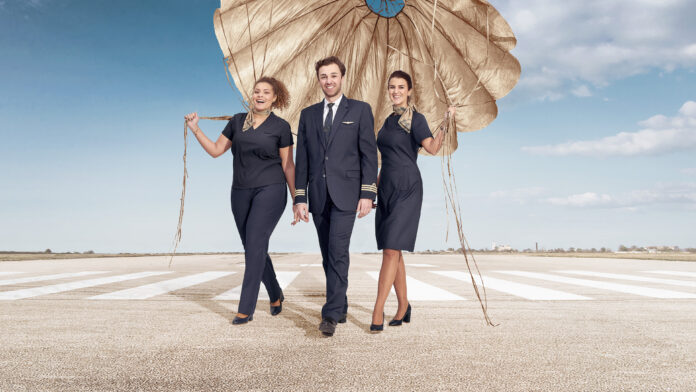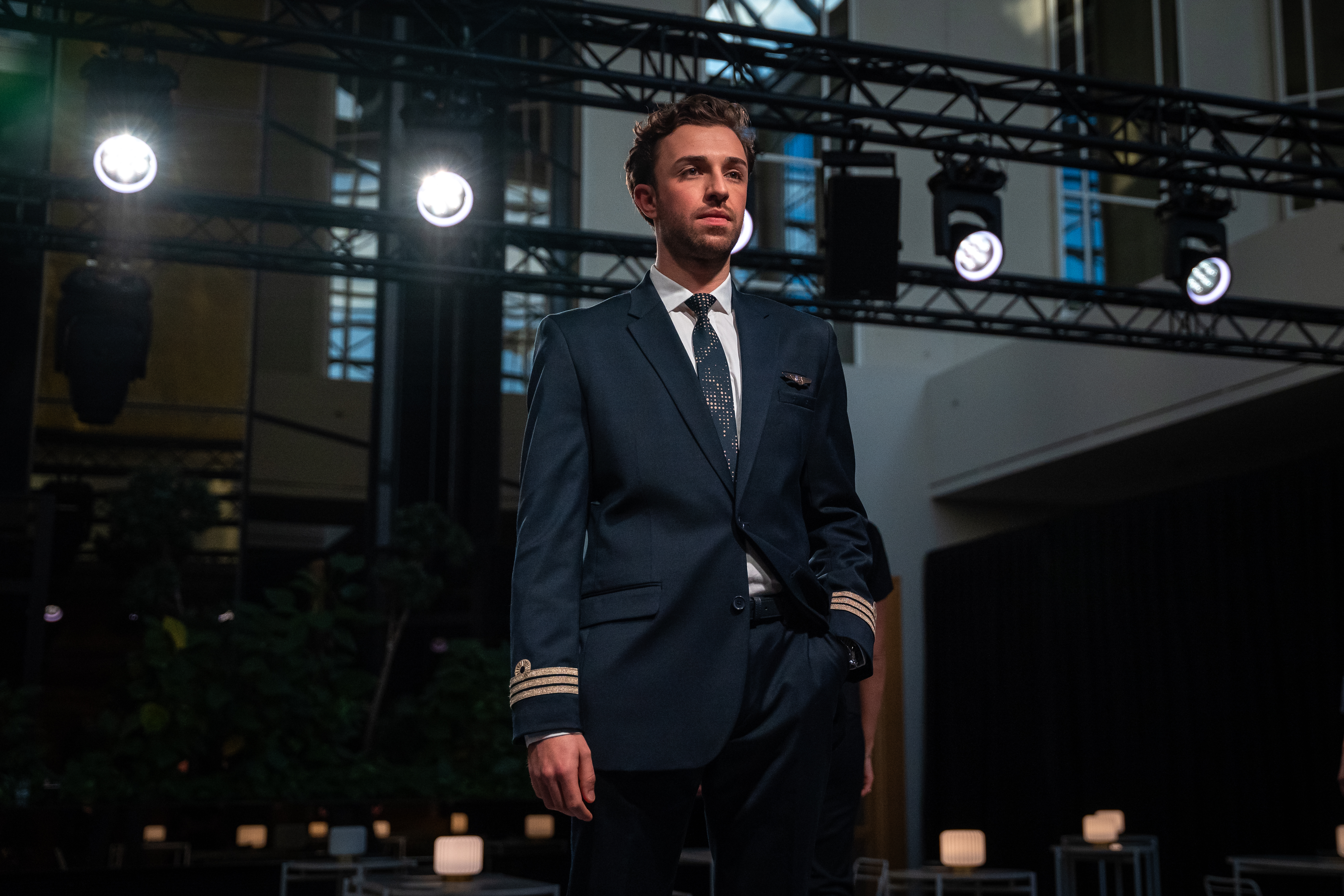Brussels Airlines just launched its brand-new uniforms for its cabin, cockpit and ground operations employees. By choosing Gabrielle Szwarcenberg, a young designer from the Royal Academy of Fine Arts Antwerp, and several other established Belgian brands, the airline once again emphasizes its Belgitude. Innovative materials, such as grapes and cacti make the uniform more sustainable. The accompanying style guide has also completely been reviewed to become much more inclusive.
At a fashion show for staff and press, the new Brussels Airlines’ uniforms were presented to the world. The uniforms will be introduced on-board and at the airport as from the first of March and worn by over 2,600 cabin, cockpit and ground operations’ employees.
The design
The new uniforms are dark navy blue with champagne-coloured details. The new colour palette and prints were designed to align seamlessly with the new Brussels Airlines branding, introduced in November 2021. The collection is inspired by glamorous airline uniforms from the sixties, resulting in contemporary yet timeless silhouettes, hence the introduction of the turtleneck and the A-line dress.
The uniforms are comfortable and look good on all body types and people of all ages. Unisex pieces are introduced, next to sneakers that are a comfortable complement to the vegan-leather shoes.
The entire design process took two years. With surveys, workshops and design sessions, the uniform was created in close collaboration with frontline employees.
“I wanted the design to be elegant and sophisticated, while prioritizing the staff’s performance and comfort. That’s why we introduce items like turtlenecks or sneakers, to make everyone comfortable. Throughout the design, you’ll also find subtle references to Belgian icons, such as the Atomium on the scarfs and on the inner lining of the blazers. I really hope the staff enjoys wearing the uniform as much as I enjoyed creating it.”
- Gabrielle Szwarcenberg, designer
Collaborating with The Royal Academy for Fine Arts in Antwerp – that has delivered some of the world’s most influential fashion designers – and Gabrielle Szwarcenberg specifically reinforces Brussels Airlines’ commitment to its Belgitude and flying the best of Belgium around the world. That’s also why the airline selected Belgian brands Atelier Content and Ambiorix for the shoes.
More sustainable uniforms
Every single supplier involved in this project has gone the extra mile to reduce the environmental impact involved in the production of the new uniform and its accessories.
From BCI-certified cotton, mulesing free wool for animal welfare, innovative materials such as leather from cacti and grapes to the packaging: the materials used for the uniforms represent a big step forward in the sustainability strategy of Brussels Airlines. All production sites were screened on both sustainability and fair working conditions.
The current uniforms will be collected and will be given a second life , more details will be announced later.
“These uniforms perfectly embody everything Brussels Airlines stands for: Belgitude, a platform for young talent, sustainability, and inclusion. I’m happy to see the result and can’t wait to see these uniforms live at the airport and on-board our aircraft. I would like to thank all the staff members who were involved in this monumental project.”
- Tilman Reinshagen, COO, Brussels Airlines
More inclusive uniform policies, evolving with society
Together with the new uniform, Brussels Airlines has also updated its style guide. The airline aims to make everyone feel at home, and that of course includes its employees. These new guidelines should contribute to a higher wellbeing at work of all uniformed staff members by making them feel comfortable wearing the uniform.
Hair, makeup and jewelry guidelines will no longer be different for men and women. For example, when wearing make-up or nail polish certain styles and color palettes would need to be followed, regardless of the gender of the employee. Moreover, make-up becomes optional for everyone and therefore no longer mandatory for women. There is no difference in gender for the hair style neither, as soon as it touches the shoulders, it needs to be tied up or in a bun, this is a safety related instruction.
And lastly, tattoos can now also be shown as long as they comply with certain rules, such as the position, the size and what it represents.
About the materials used:
Animal friendly wool: all wool used in the items of clothing is animal-friendly and therefore also mulesing-free. The sheep are properly cared for and produce high-quality and sustainable wool, according to the Responsible Wool Standard.
BCI-certified cotton: only responsibly grown cotton from the Better Cotton Initiative is used. This means that the cotton fibers are grown in a more sustainable way, taking working conditions and the impact on the environment into account.
Recycled polyester: mainly use of recycled polyester. Therefore, the textiles are granted a Global Recycled Standard referring to at least 50% recycled fibers or materials used, such as used plastic bottles or fishing nets.
Vegan leather shoes: innovative biobased alternatives for leather are used, such as cactus- or grape-based leather. These synthetic leathers are partly produced from other industry waste streams and are 100% biodegradable in their purest form.
About sustainability in the uniforms, means:
Quality: high-quality materials to ensure the uniforms look good for longer, need fewer repairs and don’t have to be replaced as often.
Respect: both for the people wearing the uniform as for everyone who was involved making the uniforms and for the planet. Very high standards were set throughout the entire lifecycle: from the very first cotton fiber to its recycling.
Transparency: careful and informed decisions with regards to materials’ and suppliers’ selection. It was important to be aware of and understand the entire production chain. This commitment is reflected in the certification of the used materials, and in the pro-active measures taken to map out the suppliers’ network. True accountability starts with knowledge which resulted in the evaluation of each link in the supply chain

















